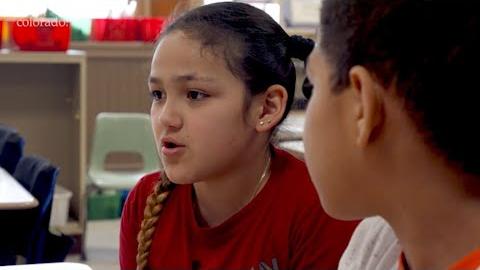Sentence Frames and Sentence Starters

Sentence frames and sentence starters are "fill in the blank" phrases and sentences that provide the structures or patterns that students need to express themselves. This strategy is part of Colorin Colorado's ELL Strategy Library and can be used to support academic language development for all students.
Professional Learning Resources
See hands-on professional learning materials below, including a slide deck with videos and activities.
Strategy Overview
How This Strategy Supports Language Development
Sentence frames and sentence starters are a helpful way to support students' academic language development both in their writing and speaking by prompting students to discuss content with more complex structures and thinking. Using these structures allows students to focus on the content concepts or skill without providing the answers. They also indirectly teach how content-specific language appears in context.
Sentence frames can be used for writing and in discussions. For example, the target concepts might include:
- Mechanical: Punctuation, paragraphing, capitalization
- Grammatical: Tenses, subject-verb agreement, articles, prepositions
- Discourse: Agreement, disagreement, persuasion
- Purpose: Comparing, drawing conclusions, citing evidence
Step-by-Step Instructions
Before Instruction
- Identify the skill or content you wish to target.
- Develop sentence frames or stems that support that goal.
- Differentiate sentence frames by proficiency level.
- Translate the sentence frames and stems.
During Instruction
- Introduce the frames/stems to students.
- Explain how to use the sentence frames/stems.
- Model how to use them.
- Give students practice using the frames in speaking and writing.
After Instruction
- Post the frames on the wall.
- Provide students with printed versions for their binders.
- Refer back to the stems/frames often.
- Celebrate students’ use of them.
- Reduce the use of frames as students gain proficiency in expression.
Targeting Language Production
In order to create a sentence frame that fits the type of response you are looking for, follow these steps:
- Write or say a model response to your question or prompt.
- Analyze the structure of the sentence(s) in that response. Look for sentence structures that meet the language function (argue, explain, inform, narrate, justify, describe, etc. of the prompt or question).
- Write one or more sentence frames to support students.
See additional strategies that reference Sentence Frames and Sentence Starters.
Lessons Learned
- Keep sentence frames open enough so that students have options for completing the frames.
- Provide frames with the most common structures or patterns for the language function in the prompt. For example, in order to compare two concepts, students will need words such as "both," "also," or "similarities."
- Give students a choice to use the frame or try their own way of expressing themselves.
- Listen to students during a discussion. If they need support using academic English or more complex sentence structures, offer a sentence frame on the board or a sticky note.
Reduce or eliminate the frames when students can speak and write precisely using content-specific language without them.
Keep in mind that sentence frames can support students' discussion skills by providing phrases they can try when agreeing, disagreeing, or adding onto a classmate's comment. See more in Developing Students’ Discussion Skills.
Co-Teaching Considerations
Content or Grade-Level Teacher
- During a co-planning session or in shared lesson plans, write a model response to a question or prompt.
- Include key vocabulary and expected sentence structures for the grade level and prompt.
English Language Development Teacher
- Create leveled sentence frames based on the model response.
- Write the frames on the board during the lesson to support students during discussions or written activities.
- Listen to students as they discuss and add or remove frames as needed.
How to Differentiate by Language Level
Differentiate for different language levels by creating some basic frames and other more complex sentence structures that structure output for specific language purposes.
Here are more specific examples:
| Prompt | Differentiated Frames |
|---|---|
| Describe the main character in the story. | Entering/Emerging: The character is ______. Developing: I think the character is ______ because ______. Expanding: I can infer the character is ______, since she ______. |
| Compare plant and animal cells. | Entering/Emerging: Plant and animal cells both have ______. Developing: Like the plant cell, the animal cell also contains ______. Expanding: Some similarities between the plant and animal cell include ______. |
| Explain how you solved the problem. | Entering/Emerging: First, I ______. Then, I ______. Finally, I ______. Developing: I solved the problem by ______. After that, I ______. My last step was ______. Expanding: My first step in solving the problem was to ______. Then I ______, in order to ______. To get the result I ______. |
More Examples
| Prompt with a thinking verb | Possible sentence frames |
|---|---|
| Compare ___ and ___. | •There are several similarities between __ and ___ such as ___, ___, and __. • ___ has ___, while ___ has__. |
| Describe a ___. | • ___ has ___, ___, and ___. • ___is ___, ___, and ___. • Some characteristics of __ are __. |
| Discuss ___. | • One perspective is from ___, who believes that___. • Some believe ___, while others suggest ___. |
| Summarize the text, video, or concept. | • The main idea of ___ is ___ • Basically, this text/video/concept is about ___ |
| Grade Level | Examples |
|---|---|
| Elementary | The character is ______. I like to eat ______. My favorite ______ is ______. |
| Middle School | Like the plant cell, the animal cell also contains ______. I solved the problem by ______. After that, I ______. My last step was ______. I agree with _____ because ______. |
| High School | My first step in solving the problem was to ______. Then I ______, in order to ______. To get the result I ______. |
Professional Learning Session: Sentence Frames
This slide show (presented in Google slides) walks through the Accountable Talk strategy. You are welcome to share these slides in professional learning settings! Please share attribution to Colorín Colorado.
Here are some tips for using this slide deck:
- We recommend that you look through the slides first to get familiar with the content, activities, and pacing. Some slides include videos and light animation.
- We also recommend that you plan how much time to spend on each discussion activity. Some prompts can be answered quickly; others allow for more in-depth discussion. We have not assigned suggested timing.
- You may wish to ask participants to share highlights from their discussion with the larger group so that they can learn from each other.
- There are no notes; everything you need to present is available on the slides themselves.
To edit this presentation, you can download or copy the slides:
- File > Download (no Google account required)
- File > Make a copy (Google account required)
Videos: Sentence Frames
In this video, Ms. Samantha Kirch demonstrates the ways she uses informal assessment to gauge student understanding, as well as the kinds of support offered to ELLs who need some extra practice with the concept of drawing conclusions. A related video features ESOL specialist Sheila Majdi explaining how to use sentence frames.
Resources
Related Resources
- Shareable Summary of Sentence Frames: Colorín on the Go
- Helping Young Multilingual Learners Develop Their Metacognitive Skills (Edutopia)
Sentence stems & frames for discussion
- Accountable Talk Frames to Support Language Functions
- Discussion sentence starters (Arlington Public Schools)
- Accountable Talk: Discussion Starters (Mississippi Department of Education)
For more in-depth resources, see:
- Teaching with the WIDA 2020 ELD Standards in a Second-Grade Literacy Block by Dr. Ruslana Westerlund
- The Writing-Centered Classroom (ASCD)
- Scaffolding Writing Through the "Teaching and Learning Cycle" (WestEd)
- Scaffolding Writing With the “Teaching and Learning Cycle” for Students in Grades 6–12 (WestEd)
- Teaching-learning cycle: reading and writing connections (Victoria State Government)
References
- Using Sentence Frames to Develop Academic Vocabulary for English Learners (International Reading Teacher)
- Scaffolds to Support English Language Learners in Writing and Discussion (Achieve the Core)
- Sentence Frames and Stems (Valentina Gonzalez)







